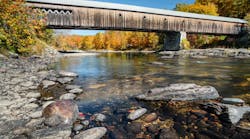The U.S. Environmental Protection Agency (EPA) has announced a new director of the Chesapeake Bay Program.
EPA’s Chesapeake Bay Program coordinates activities and implements strategies for meeting the restoration goals of the Chesapeake Bay watershed, which covers 64,000 square miles across New York, West Virginia, Pennsylvania, Delaware, Maryland, Virginia and the District of Columbia. Kandis Boyd has been selected as the program's new director and will start her new role as on June 6.
“I’m thrilled to have Kandis join our leadership team as we are stepping up restoration efforts for the Bay in the face of emerging challenges,” said EPA Mid-Atlantic Regional Administrator Adam Ortiz. “Her experience as a strategic leader in the sciences and success engaging diverse communities and youth will help take the Bay effort to a new level as we focus on climate change and vulnerable communities.”
“I’m extremely humbled and excited to work with a forward-focused team of specialists and experts to advance the ongoing work of EPA and the Chesapeake Bay partners,” said Boyd. “I’m ready to dive in and get to work on the most pressing matters before us.”
Boyd has nearly 30 years of experience leading, teaching, advising, and mentoring students and early career enthusiasts in environmental and atmospheric science. Her skillset as a strategic thinker, change agent, and leader includes designing, developing, and managing cutting edge initiatives to advance STEAM — science, technology, engineering, arts, and math.
She previously served as the Strategic Advisor for the National Science Foundation’s (NSF) Office of Equity and Civil Rights. Boyd championed key agency-wide initiatives to broaden participation and to reduce the gap between future STEAM careers and experienced professionals needed for these positions, particularly in the areas of diversity, equity, inclusion, and accessibility. Her previous position included serving as the first Deputy Division Director of the NSF Division of Grants and Agreements, in which she provided oversight and direction for 35 individuals, a $5 billion budget, and over 12,000 new grants annually.
Boyd was the first African-American female to receive an undergraduate degree in Meteorology from Iowa State University in 1996. After receiving her degree, she began her career at the National Oceanic and Atmospheric Administration (NOAA). Her NOAA career highlights include spearheading the Turn Around Don't Drown program, delivering around-the-clock on-site meteorological forecasts during the 2005 landfall of Hurricane Katrina, serving as the designated federal officer for the third National Climate Assessment Development Advisory Committee, co-chairing the first NOAA Environmental Modeling Strategic Plan, serving as a Subject Matter Expert for NOAA’s $2 billion satellite portfolio, and leading as both the acting director and deputy director of the NOAA Weather Program Office.
Boyd has mentored over 50 students, authored three books, written over 100 articles and hosted over 30 podcasts to date. In addition, she is an American Meteorological Society (AMS) Fellow, which is the highest honor bestowed by this organization. She was also the recipient of the 2021 Charles E. Anderson Award from the American Meteorological Society for her career-long efforts toward advancing diversity and inclusion.






